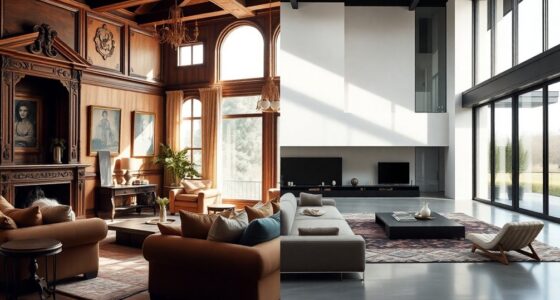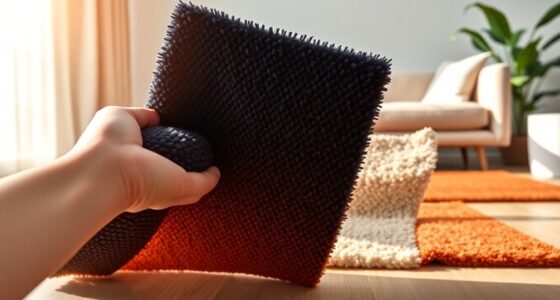Modern and classic house designs really stand apart in several key ways. If you prefer sleek lines and open spaces, modern homes embrace minimalism and energy efficiency using materials like steel and glass. In contrast, classic designs focus on intricate craftsmanship, with features like gabled roofs and ornate moldings, showcasing timeless beauty. You'll notice modern homes often have larger, interconnected rooms, while traditional ones maintain defined spaces. Both styles offer unique values, catering to different tastes and lifestyles. Curious about how these styles can blend to create personalized spaces? There's plenty more to explore on this fascinating topic!
Key Takeaways
- Modern house design emphasizes minimalism and open spaces, while classic house design focuses on intricate details and symmetry.
- Traditional homes feature compartmentalized layouts with inviting front porches, contrasting with the open concept of modern homes.
- Modern architecture utilizes materials like steel and glass, whereas classic designs incorporate natural materials such as oak and stone.
- Energy efficiency is prioritized in modern homes with advanced insulation and smart technology, while traditional homes may lack these features.
- Blending elements from both styles can create unique spaces that reflect both modern efficiency and classic elegance, enhancing aesthetic appeal.
Overview of Architectural Styles
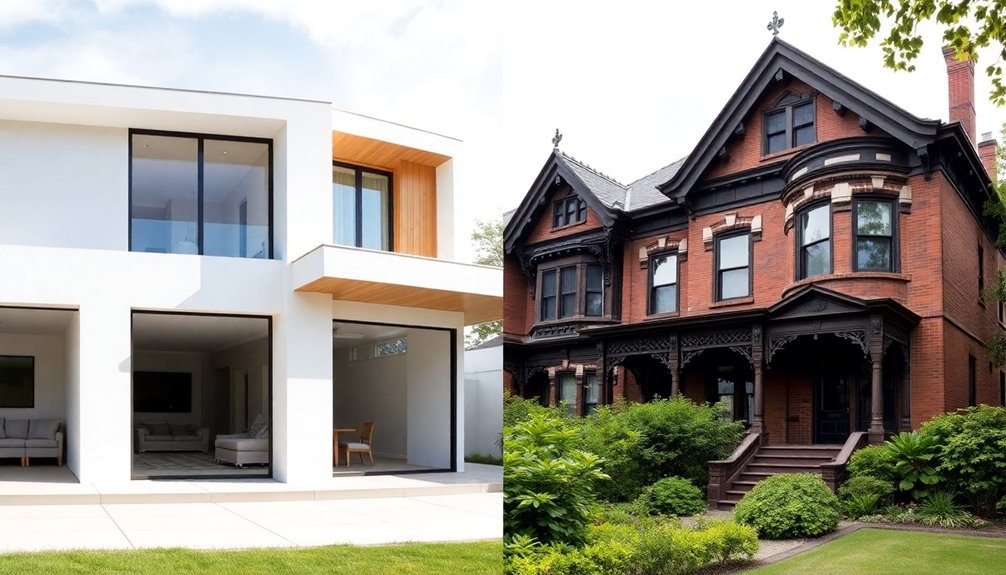
When exploring architectural styles, you'll notice a distinct contrast between modern and classic designs.
Modern architecture emphasizes minimalism, functionality, and open spaces, utilizing materials like steel, concrete, and glass. This design approach prioritizes energy efficiency and eco-friendly features, creating sleek, innovative homes that harmonize with nature.
In contrast, traditional architecture, represented by styles such as Victorian and Colonial, showcases timeless beauty through intricate details and craftsmanship. Classic homes often include compartmentalized spaces, brick, wood, and stone, exuding warmth and character.
While modern designs focus on large windows and clean lines for aesthetic appeal, classic homes celebrate their historical significance, making them equally enthralling in their own right.
Each style reflects unique values and preferences, enriching our architectural landscape.
Characteristics of Traditional Homes
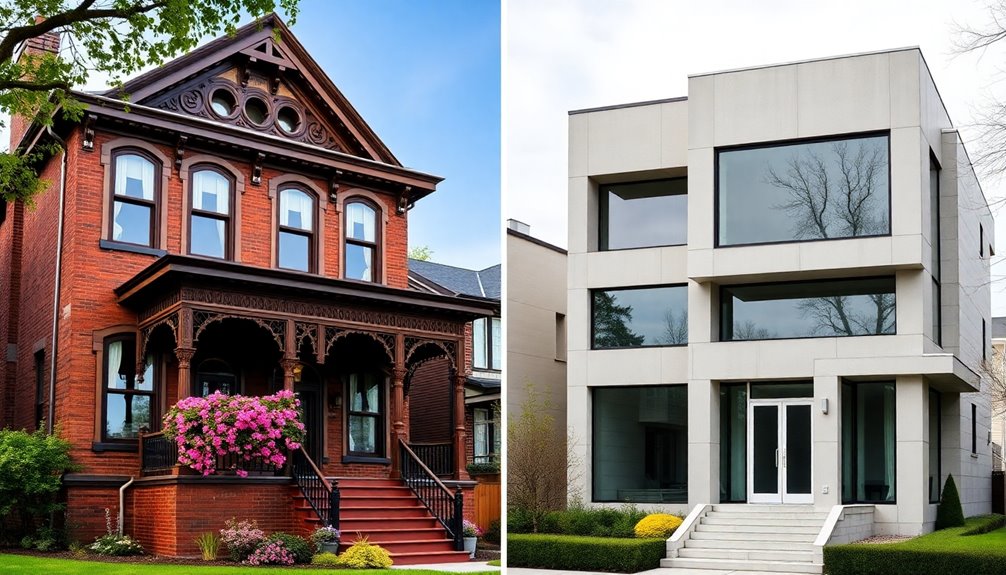
Traditional homes stand out with their intricate craftsmanship and distinctive architectural features. You'll notice the charm and warmth they exude through:
- Gabled roofs that add character and elegance.
- Ornate moldings showcasing detailed woodwork and local artisanship.
- Natural materials like oak, pine, and stone, ensuring durability.
These homes emphasize symmetry and historical architectural styles, appealing to those who appreciate craftsmanship and cultural heritage.
The interior design typically features compartmentalized spaces, creating cozy atmospheres tailored for distinct purposes.
With inviting front porches and dormer windows, traditional homes invite you to experience their timeless beauty.
Each architectural detail reflects a commitment to quality and longevity, making traditional homes a lasting choice for many.
Features of Modern Homes
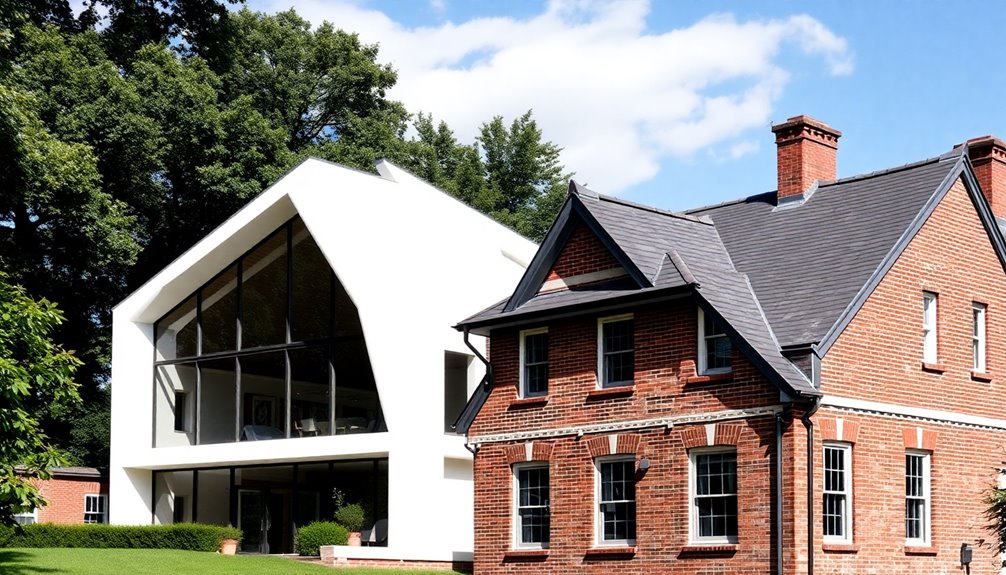
Modern homes embrace open concept layouts, making your living space feel larger and more connected.
You'll notice a minimalist aesthetic, with energy-efficient materials that not only look sleek but also reduce environmental impact.
This design approach prioritizes functionality and style, creating a revitalizing atmosphere in your home. Additionally, modern homes often incorporate smart home device integration, enhancing the overall convenience and efficiency of household management.
Open Concept Layouts
Have you ever wondered how open concept layouts transform the way we live and interact at home?
In modern homes, these designs break down traditional walls, creating an expansive space that encourages social interaction.
Here are three key benefits:
- Enhanced Natural Light: Fewer walls mean more sunlight, brightening your home.
- Flexibility: Open concept layouts let you use multifunctional furniture, adapting effortlessly to various activities.
- Contemporary Living: These spaces prioritize leisure and communal gatherings over compartmentalized rooms, fostering connectivity among family and guests. Additionally, the use of natural materials in furniture further enhances the warm and inviting atmosphere typical of modern farmhouse design.
Energy-Efficient Materials
As homes evolve to foster more open and inviting spaces, energy-efficient materials play an essential role in enhancing both comfort and sustainability.
Modern homes frequently use advanced insulation materials that can cut heating and cooling costs by up to 30% compared to traditional houses.
Energy-efficient windows minimize heat loss by up to 50%, thanks to double or triple glazing and low-emissivity coatings.
Many modern designs incorporate eco-friendly materials like reclaimed wood and recycled steel, boosting durability while reducing environmental impact.
The integration of smart home technology also allows you to monitor energy usage, potentially saving up to 15% on utility bills.
Plus, renewable energy sources like solar panels considerably decrease reliance on fossil fuels, providing long-term savings. Additionally, incorporating energy-efficient water systems in modern bathrooms further enhances sustainability by significantly reducing water consumption.
Minimalist Aesthetic Design
There's something invigorating about the minimalist aesthetic found in modern homes, where clean lines and open spaces create a sense of tranquility.
This unique style emphasizes simplicity and functionality, setting it apart from traditional design elements. Here are three key features of the minimalist aesthetic:
- Large windows that flood the space with natural light, connecting indoor and outdoor environments.
- Neutral color palettes accented with bold pieces, maintaining a fresh, airy vibe while avoiding visual clutter.
- Sustainable materials and energy-efficient technologies promote eco-friendly practices without sacrificing style.
In modern design, furniture is often multi-functional and minimalistic, focusing on innovative solutions that declutter your space, allowing you to truly enjoy the beauty of simplicity.
Key Design Differences
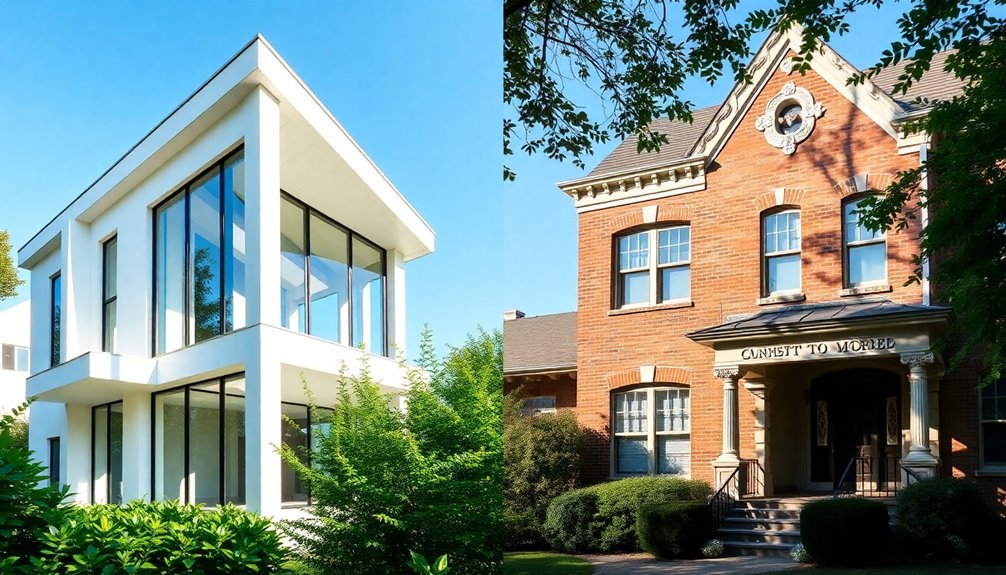
When comparing modern and classic house designs, you'll notice distinct architectural features and space utilization strategies.
Modern homes focus on open layouts and sleek materials, while classic designs emphasize segmented rooms and traditional materials.
Understanding these key differences can help you appreciate the unique charm of each style.
Architectural Features Comparison
Architectural features reveal striking contrasts between modern and classic house designs. When you explore these styles, you'll notice three key differences:
- Design Aesthetic: Modern homes emphasize clean lines and minimalist elements, while traditional homes feature intricate details and symmetrical layouts.
- Materials Used: Classic designs often incorporate brick, wood, and stone, showcasing natural tones. In contrast, modern architecture utilizes industrial materials like glass and steel for a sleek, durable appearance.
- Space Configuration: Traditional homes typically have defined living areas that support single-purpose rooms, whereas modern designs promote multifunctional spaces, encouraging seamless shifts throughout the home.
These architectural features highlight how design philosophies shape the way we experience our homes, influencing both functionality and aesthetics.
Space Utilization Strategies
While traditional homes often prioritize compartmentalized floor plans, modern designs embrace open-concept layouts to enhance space utilization. This shift encourages multifunctional use of areas, allowing you to adapt your space according to your needs.
In contrast to the defined spaces of classic homes, modern designs promote fluid transitions and seamless integration of indoor and outdoor environments. The architectural focus on maximizing natural light through oversized windows creates an airy feel, unlike the smaller, decorative windows of traditional homes.
Additionally, modern houses often feature innovative storage solutions and multifunctional furniture that optimize space efficiency. Varied flooring and lighting techniques help delineate distinct areas without relying on walls, making modern homes both functional and visually appealing. Furthermore, incorporating natural materials into the design can enhance the overall ambiance and sustainability of modern spaces.
Energy Efficiency and Sustainability
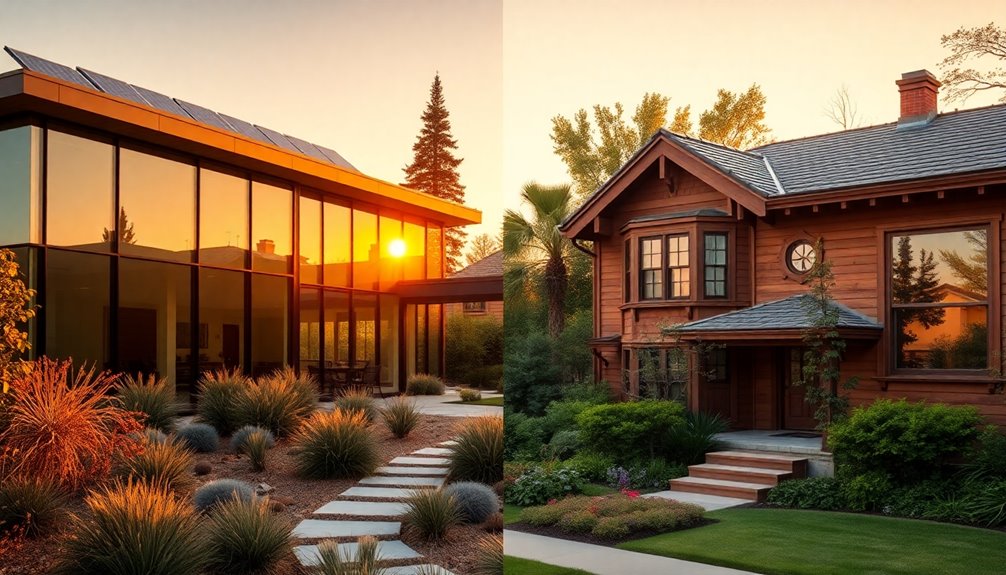
Modern house designs emphasize energy efficiency and sustainability, ensuring that homeowners can enjoy lower utility bills and a reduced environmental impact.
Here are three key features of modern homes that enhance energy efficiency:
- Advanced Insulation Materials: These considerably reduce heating and cooling costs compared to traditional homes.
- Energy-Efficient Windows and Doors: Modern designs minimize heat loss, providing better climate control than classic architecture.
- Smart Home Technology: This allows you to monitor and control energy consumption remotely, enhancing sustainability. Additionally, many municipalities have adopted specific tiny house regulations that promote energy-efficient building practices.
Blending Styles for Unique Aesthetics
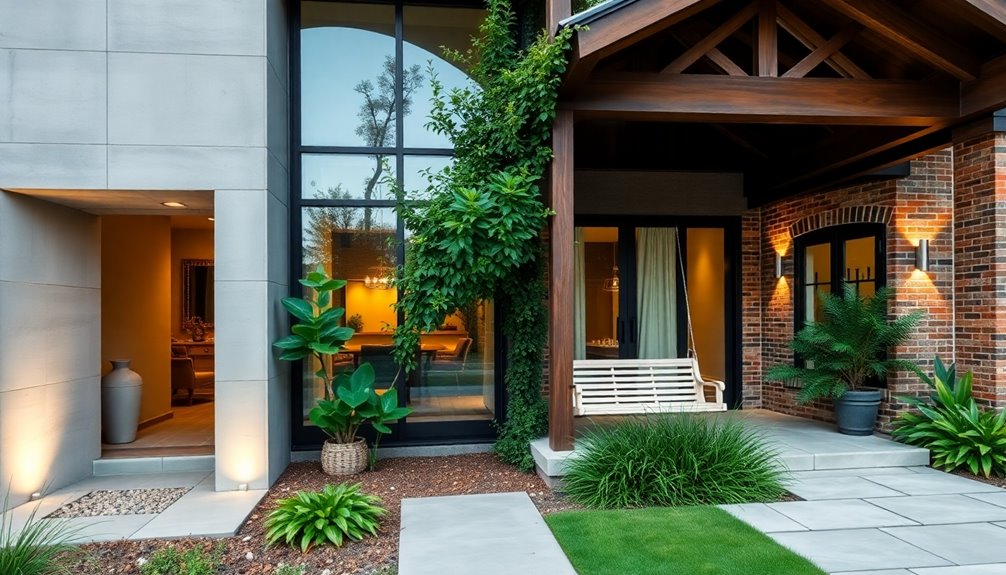
Blending modern and classic design elements can create a visually stunning and personalized space that reflects your unique style.
By incorporating traditional elements like crown molding and wainscoting into a modern layout, you can achieve an inviting atmosphere. Using materials such as reclaimed wood or vintage fixtures adds a sense of history while keeping a contemporary feel.
Mixing furniture styles—pairing minimalist modern pieces with ornate traditional items—enhances visual interest and showcases your personal journey.
Additionally, you can harmoniously integrate architectural features, like large modern windows with traditional gabled roofs, to balance light and historical charm.
This approach to home design allows for unique aesthetics that truly represent who you are.
Frequently Asked Questions
What Is the Difference Between Modern and Classic Houses?
When you look at modern and classic houses, you'll notice key differences.
Modern houses feature open floor plans and large windows for natural light, while classic homes often have smaller, compartmentalized rooms.
Regarding materials, modern designs use steel and glass, embracing simplicity, whereas classic houses showcase brick and wood with intricate details.
Aesthetically, modern homes lean towards minimalism, while classic ones evoke a sense of history and craftsmanship, creating distinct vibes.
What Is the Difference Between Modern and Classic Design?
When you're exploring the difference between modern and classic design, you'll notice that modern design embraces simplicity and clean lines, creating a fresh, airy feel.
Classic design, on the other hand, showcases intricate details and historical elements that evoke warmth and charm.
While modern spaces often feature open layouts and minimal decor, classic designs tend to prioritize symmetry and craftsmanship, making each style unique in its aesthetic and functional approach.
What Is the Difference Between Old House and Modern House?
You might think living in an old house means embracing charm, but it often comes with quirks like drafty windows and compartmentalized rooms.
In contrast, modern houses boast sleek lines and open spaces, prioritizing energy efficiency and natural light.
While old homes celebrate craftsmanship with intricate details, modern designs use industrial materials for durability.
What Makes a House Classic?
A house is considered classic when it embodies historical architectural styles, showcasing elements like gabled roofs, arched doorways, and symmetrical windows.
You'll notice intricate woodwork, crown molding, and decorative finishes that create a warm, inviting atmosphere.
Classic homes often feature compartmentalized layouts, prioritizing function and intimacy.
Their exteriors, made of brick or stone, highlight craftsmanship and are enhanced by traditional landscaping, giving them a timeless charm that resonates with cultural significance.
Conclusion
To sum up, whether you lean towards classic charm or modern minimalism, both styles have their unique appeal. Did you know that approximately 60% of homebuyers prefer modern designs for their energy efficiency? This trend highlights how modern homes not only look good but also help save on energy bills. Ultimately, blending elements from both styles can create a stunning and functional space that reflects your personal taste while embracing the best of both worlds.


